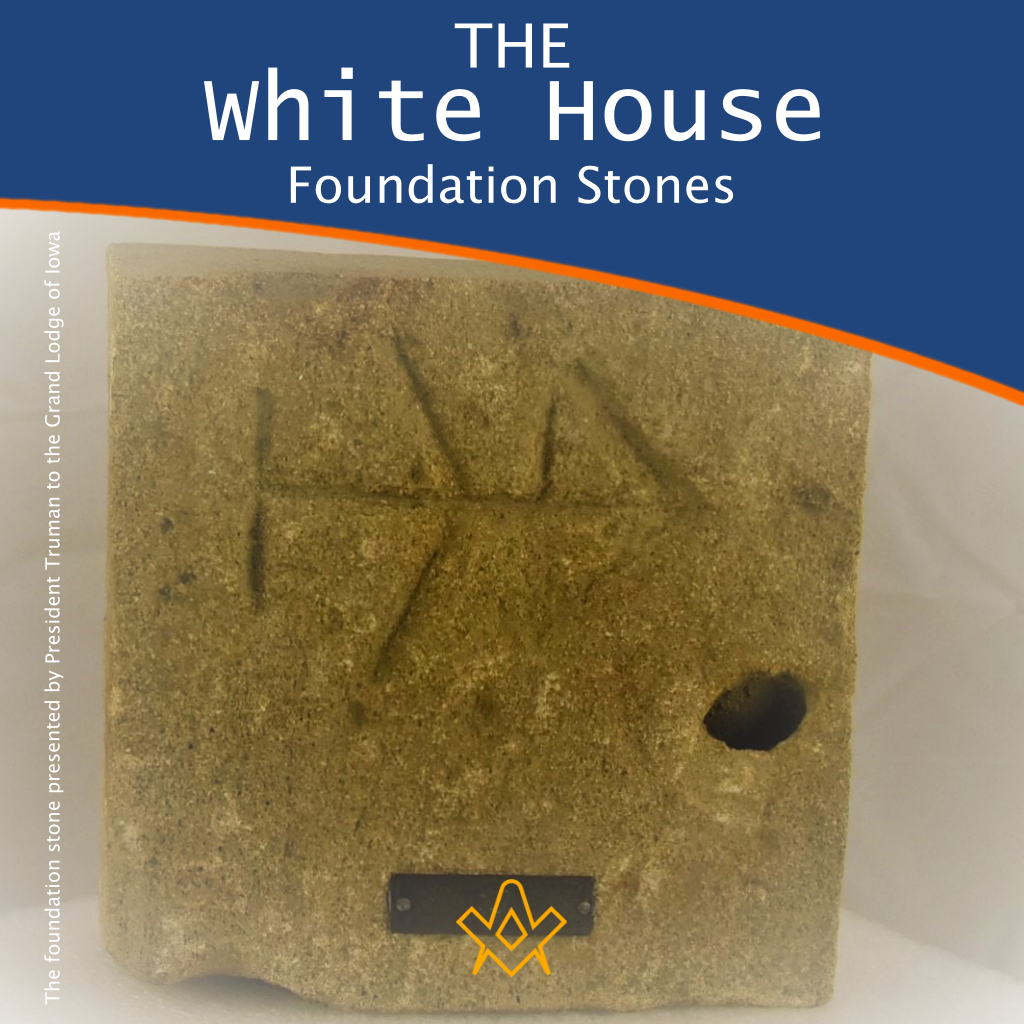Further to the articles in our series on the history of the stone masons, we have a rather intriguing addition. During the 1950’s renovation of the White House, President Truman retrieved more than 100 stone blocks with stonemasons marks.
When I was visiting the Grand Lodge of Iowa’s Masonic Museums in Cedar Rapids, my eye was caught by some fairly unassuming stone blocks which appeared to be carved with Mason’s Marks.
I thought perhaps they were just practice pieces by operative stone masons that had been absorbed into the collection, but Museum Curator Bill Kreuger told me of their interesting history in connection with the presidential White House in Washington D.C.
In 1946, shortly after WWII, President Harry S. Truman had moved into the White House he noted in a letter to his wife Bess that: “The floors pop and the drapes move back and forth. I can just imagine old Andy [Jackson] and Teddy [Roosevelt] having an argument over Franklin [Roosevelt].” [1]
It was not only the President who noticed the precarious state of the building:
During a formal reception in the Blue Room, the First Lady noticed the very large crystal chandelier overhead swaying and its crystals tinkling.
The floor of the Oval Study above moved noticeably when walked on, and a valet was then attending the president while he was taking a bath.
(Truman described a potential scenario of him in his bathtub falling through the floor into the midst of a Daughters of the American Revolution tea “wearing nothing more than his reading glasses.”)
In early 1947, a “stretching” chandelier in the East Room and another swaying in the Oval Study caused further alarm. “Floors no longer merely creaked; they swayed.”
– Source: Wikipedia
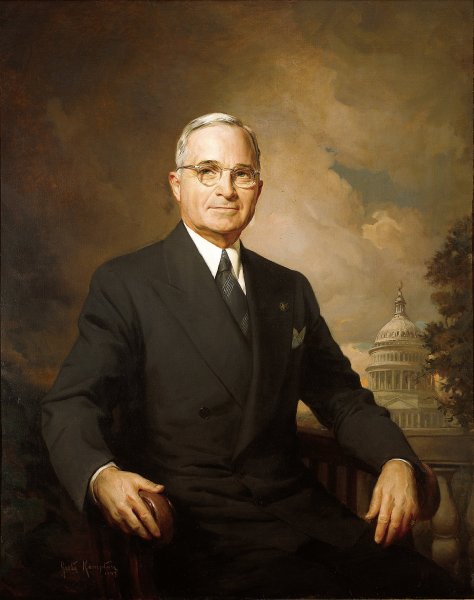
Official portrait of President Truman by Greta Kempton, c.1945, now in the Harry S. Truman Library.
IMAGE LINKED: wikimedia Attribution 4.0 International (CC BY 4.0)
By 1948, the President was justified in his concerns about the condition of the building when engineers confirmed the worst fears that the White House was literally falling down. Structurally weak, it was in certain danger of collapse due to a combination of factors including an extensive fire in 1814, and later additions and major modifications to the interior in the early twentieth century.
It was reported that some had quipped that the White House “was standing only from the force of habit”. [2]
The Trumans moved out of the building into Blair House across the street, and in December of 1949, the renovation of the White House began, a massive project that would take three years.
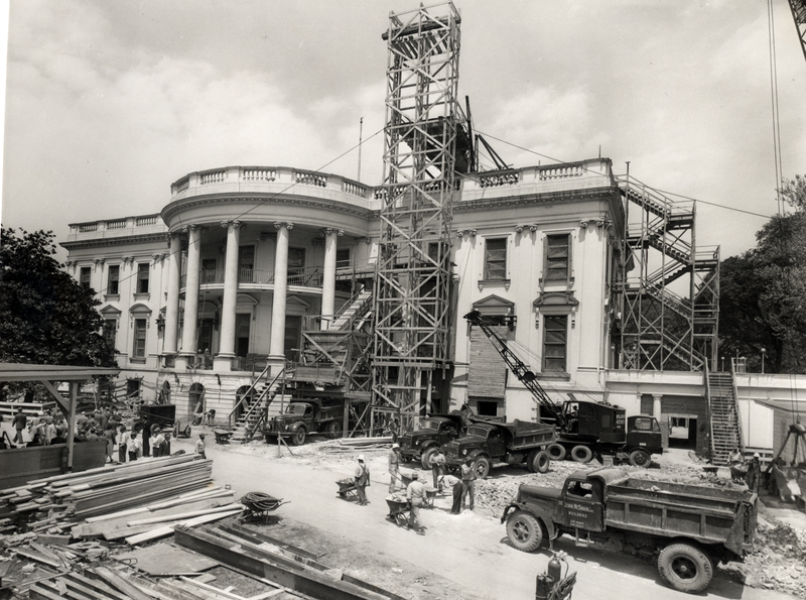
Renovation work on the South Portico of the White House, 1950
IMAGE LINKED: Rowe, Abbie National Park Service Accession Number 71-298, Harry S. Truman Library & Museum. (CC BY 4.0)
President Truman was a well-known Freemason, whose Masonic journey started in Belton Lodge No. 450, Missouri, in 1909. He moved swiftly through his degrees; in 1911 he helped establish Grandview Lodge, and served as the first Worshipful Master.
In September 1940, Truman was elected Grand Master of the Missouri Grand Lodge of Freemasonry, then in 1945, he was made a 33° Sovereign Grand Inspector General and an Honorary Member of the supreme council at the Supreme Council A.A.S.R. Southern Jurisdiction Headquarters in Washington D.C.
He was also a member of two affiliated bodies of Masonry, the Shriners and the Royal Order of Jesters, and was elected an Honorary Grand Master of the International Supreme Council, Order of DeMolay.
On May 18, 1959, Illustrious Brother Truman was presented with the fifty-year award, a golden anniversary in Freemasonry. [3]
One day during a tour of the demolition site, President Truman noticed amongst the rubble that a large number of the interior blocks had a mark upon them.
As a Freemason, Truman was well-qualified to notice, and interpret the marks as those made by stone masons.
He then made it his mission to have as many of the blocks retrieved, and more than 100 were delivered to the nearby Grand Lodge of the District of Columbia’s Headquarters on New York Avenue.
In 1952, Truman asked the Grand Lodge to send one of the marked stones to each United States Grand Lodge. A small brass plaque was affixed to each block, and a letter to the Grand Master from the President accompanied the stones:
“These evidences of the number of members of the Craft who built the President’s official residence so intimately aligns Freemasonry with the formation and the founding of our Government that I believe your Grand Lodge will cherish this link between the Fraternity and the Government of the Nation, of which the White House is a symbol.”
Origin of the White House Stones
In May 2011, Mark A. Tabbert, Director of Collections of the George Washington Masonic Memorial, organised an exhibit at the Museum in Washington D.C., which featured 45 of the White House Stones President Truman had donated to the Grand Lodges. The exhibit opened in conjunction with the Memorial Association’s 100th Anniversary.
Describing the stones, he stated that:
Each stone is marked by a Scottish stonemason who helped build the White House. The stones are reassembled for the first time since President Harry S. Truman sent one to every United States Masonic Grand Lodge in 1952.
Complementing the stones is a minute book from The Lodge of Journeymen Masons No. 8 of Edinburgh, Scotland.
It lists members of the lodge who, in 1794, immigrated to help build the White House. Accompanying the minute book is the lodge’s mark book, showing each stonemason’s trade mark.
By comparing these marks to the marks on the stones, visitors may identify the men who helped to build the President’s House.
Concerning the origin of the stones:
In 1789, president George Washington and the United States Congress were determined to build a great capital city.
By 1792 the site was chosen, designer Pierre L’Enfant’s street plan was adopted, and work began.
At the city’s center would be the United States Capitol, the “People’s House.” The President’s House would be located on Pennsylvania Avenue.
Washington reviewed the site and personally selected architect James Hoban’s design. The mansion’s cornerstone was laid with a small civic and Masonic ceremony on October 13, 1792.
Although foundation work then began in earnest, the government soon discovered that the young nation had an abundance of craftsmen but few master stonemasons. What’s more, those it did have were working on the United States Capitol.
After a thorough search in America and Europe, agent George Walker traveled to Edinburgh, Scotland. By spring 1794 he had recruited at least eight stonemasons from The Lodge of Journeymen Masons No. 8.
With the arrival of the eight Scots stonemasons, the White House walls rose to completion in 1798.
During construction, the stonemasons, being Freemasons, joined the local lodge. Federal Lodge No. 15 had been chartered September 12, 1793 by the Grand Lodge of Maryland.
James Hoban was its first Worshipful Master. Federal Lodge became the first lodge when the Grand Lodge of the District of Columbia was constituted in 1811.
The exhibit also includes Federal Lodge’s first account book listing the Scots stonemasons and White House architect James Hoban as its first Master. Additional materials include a letter from President Truman, historic photographs, and other items. [4]
Mark Tabbert’s meticulous research showed that additional stones were distributed to:
Canadian Grand Lodges, several Order of The Eastern Star state Grand Chapters, a few local lodges, DeMolay International, the two United States Scottish Rite Supreme Councils, the Grand Lodge of Israel, and the Grand Lodge of the Philippines.
Many were hand delivered by Truman or by Carl Claudy, Executive Secretary of the Masonic Service Association.
In 2004, the Grand Lodge of the District of Columbia presented stones to the recently independent Grand Lodge of Alaska and Grand Lodge of Hawaii.
Below are examples of just a handful of the stones donated to the Grand Lodges.
Two held in the Grand Lodge of Iowa Library and Museums Collection:
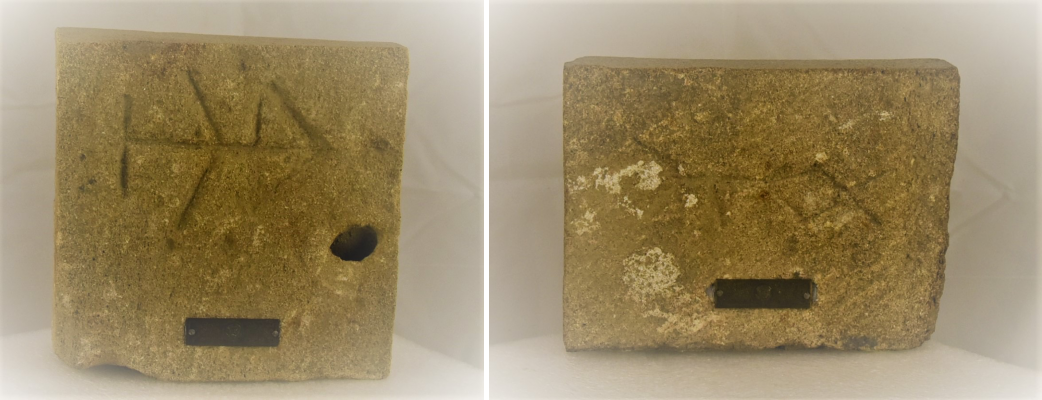
Left: The foundation stone presented by President Truman to the Grand Lodge of Iowa.
Right: Foundation stone from the White House presented in January 1966 by a professor of Mechanical Engineering at Iowa State University.
IMAGES CREDIT: Reproduced with kind permission of the Trustees of GLoI Library and Museums. All rights reserved.
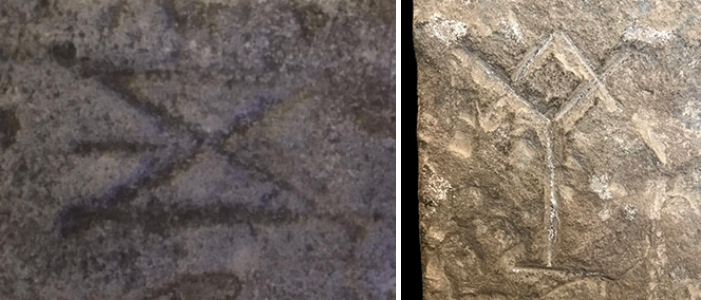
Left: Another stone was given to the Grand Lodge of Minnesota – the letter accompanying the stone is also in the collection of the Minnesota Masonic Heritage Center. Close-up of the Mason’s mark on the stone sent to the Grand Lodge of Minnesota. Photo by Mark Anderson. Image via https://masonicheritagecenter.org/
Right: The stone donated to the to the Supreme Council, 33°, S.J., on November 22, 1952., now resides in the Americanism Museum at the House of the Temple in Washington D.C. A small plaque at this stone’s base bears the presidential seal and reads “Original White House Material / Removed in 1950.” Image via https://scottishrite.org/
And one more thing…
Further to the stones from the White House, the Grand Lodge of Iowa Museum collection also has this example below. It is a stone from the east end of the United States Capitol, Washington, D.C.
This stone was placed into the foundation between 1793 and 1800. It is one of 18 stones that were removed during renovation from 1958 to 1962.
The stone was presented to the Iowa Masonic Library in late 1964 by then Congressman Fred Schwengel.
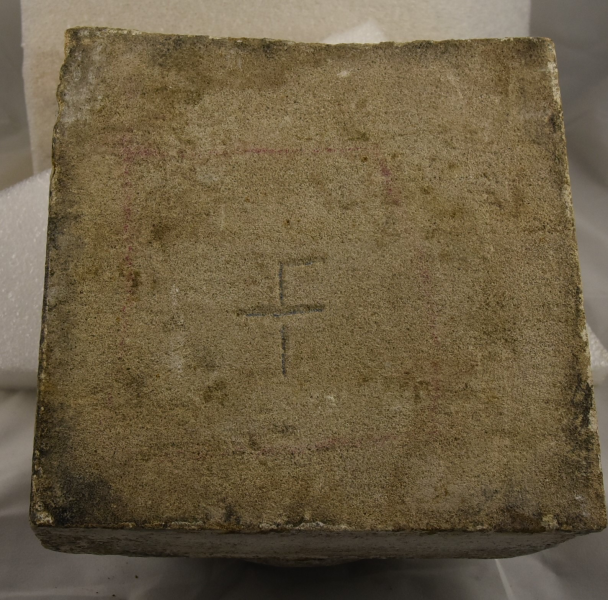
IMAGE CREDIT: Reproduced with kind permission of the Trustees of GLoI Library and Museums. All rights reserved.
Footnotes
Notes
NOTES:
[1] “The White House is Falling Down”, The White House Historical Association https://www.whitehousehistory.org/galleries/the-white-house-is-falling-down accessed 20/04/2022
[2] Ibid.
[3] “Famous American Freemason: Harry S Truman”, Midnight Freemasons, 2010 http://www.midnightfreemasons.org/2010/09/famous-american-freemason-harry-s_15.html accessed 20/04/2022
[4] Mark Tabbert http://www.knightstemplar.org/KnightTemplar/articles/20100909.htm
Further Reading & Resources
Grand Lodge of Iowa Masonic Library and Museums
https://grandlodgeofiowa.org/library-2/
“The White House is Falling Down”, The White House Historical Association https://www.whitehousehistory.org/galleries/the-white-house-is-falling-down
“Famous American Freemason: Harry S Truman”, Midnight Freemasons, 2010 http://www.midnightfreemasons.org/2010/09/famous-american-freemason-harry-s_15.html
“A White House Foundation Stone”, Aimee Newell, 2010, The Scottish Rite Museum and Library Blog https://nationalheritagemuseum.typepad.com/library_and_archives/2010/02/at-the-end-of-world-war-ii-president-harry-s-truman-1884-1972-became-aware-that-the-white-house-needed-extensive-repairs.html
“White House Piece with Stone Masons’ Marks”, https://scottishrite.org/blog/virtualtour/white-house-piece-with-stone-masons-marks/
“The White House Stone with a Mason’s Mark”, 2017, Minnesota Masonic Heritage Center, https://masonicheritagecenter.org/2017/08/white-house-stone-masons-mark/
Article by: Philippa Lee. Editor

Philippa Lee (writes as Philippa Faulks) is the author of eight books, an editor and researcher.
Philippa was initiated into the Honourable Fraternity of Ancient Freemasons (HFAF) in 2014.
Her specialism is ancient Egypt, Freemasonry, comparative religions and social history. She has several books in progress on the subject of ancient and modern Egypt. Selection of Books Online at Amazon
Recent Articles: symbolism
 The Practice of Freemasonry - P1 Embark on a transformative journey with Freemasonry, where the exploration of your Center unlocks the Perfect Ashlar within. Through the practices of Brotherly Love, Relief, Truth, and Cardinal Virtues, discover a path of enlightenment and self-improvement. Embrace the universal creed that binds us in the pursuit of our true essence. |
 Discover the fascinating history and significance of the Warrant of Constitution within Freemasonry. Unveil the evolution of this crucial authorization, its role in legitimizing Lodges, and its lasting impact on the global brotherhood of Freemasons. Explore the intricate link it provides between tradition and modern practice. |
 Freemasonry: Unravelling the Complexity of an Influential Organization Mysterious and captivating, Freemasonry has piqued the interest of seekers and skeptics alike. With its intricate blend of politics, esotericism, science, and religion, this enigmatic organization has left an indelible mark on society. Prepare to delve into the secrets of Freemasonry and unlock its hidden depths. |
 Unlocking the Mysteries of Freemasonry: In the hallowed halls of Freemasonry, a powerful symbol lies at the heart of ancient rituals and teachings—the Volume of the Sacred Law. This sacred book not only guides the spiritual and moral journey of Freemasons but also serves as a beacon of universal wisdom and enlightenment. |
 The Ancient Liberal Arts in Freemasonry Embark on a journey of self-improvement and wisdom with Freemasonry's guiding principles. Ascend the winding stairs of moral cultivation, analytical reasoning, and philosophical understanding. Embrace arithmetic's mystical properties and geometry's universal truths. Let the harmony of the universe inspire unity and growth. Discover the profound, hidden knowledge in Freemasonry's path to enlightenment. |
 Initiation rituals around the world are filled with fascinating elements and different images. One of them is that of darkness. When societies speak of darkness, they often mean a lack of knowledge, a lack of choice, or a symbol of evil. During initiation rituals, darkness is used to represent the initiate's lack of knowledge about the world, society, and initiation in general. It can also represent the initiate's inability to make a choice or endure a situation. Whether you have participated in an initiation rite or not, the meaning of darkness remains an intriguing concept worth exploring. Initiation rituals around the world are filled with fascinating elements and different images. One of them is that of darkness. When societies speak of darkness, they often mean a lack of knowledge, a lack of choice, or a symbol of evil. During initiation rituals, darkness is used to represent the initiate's lack of knowledge about the world, society, and initiation in general. It can also represent the initiate's inability to make a choice or endure a situation. Whether you have participated in an initiation rite or not, the meaning of darkness remains an intriguing concept worth exploring. |
 Masonic Deacon rods potentially trace their origins to Greek antiquity, symbolically linked to Hermes' caduceus. As Hermes bridged gods and mortals with messages, so do Masonic Deacons within the lodge, reinforcing their roles through ancient emblems. This connection underscores a profound narrative, weaving the fabric of Masonic rites with the threads of mythological heritage, suggesting the rods are not mere tools but bearers of deeper, sacred meanings that resonate with the guardianship and communicative essence of their divine counterpart, Hermes, reflecting a timeless lineage from myth to Masonic tradition. |
 The biblical pillars erected by Solomon at the Temple's porch, hold a profound place in history. These brass behemoths are not mere decorations; they are symbols of strength, establishment, and divine guidance. Explore their fascinating construction, dimensions, and the deep meanings they carry in both biblical and Masonic contexts. |
 Unlocking the Mind's Potential: Dive deep into ground breaking research revealing how simple daily habits can supercharge cognitive abilities. Discover the untapped power within and redefine your limits. Join us on this enlightening journey and transform your world! |
 Dive deep into the symbolic importance of the trowel in Masonry, representing unity and brotherly love. From its historical roots in operative masonry to its significance in speculative masonry, this article explores the trowel's multifaceted role. Discover its connection to the sword, the story of Nehemiah, and the Society of the Trowel in Renaissance Florence. Unravel the layers of meaning behind this enduring Masonic symbol. |
 Symbolism of The Builder's Jewel Batty Langley's "The Builder’s Jewel" (1741) is a visual masterpiece of Masonic symbolism, showcasing Langley's deep understanding of Freemasonry. The frontispiece highlights key symbols like the three pillars and the legend of Hiram Abiff, emphasizing Langley's dedication to Masonic traditions and teachings. |
 Unveil the mystique of the colour blue in Masonic symbolism. A hue evoking universal friendship and benevolence, its roots span ancient cultures, infusing Freemasonry's core values. This article explores blue's profound significance, guiding Freemasons towards wisdom and spiritual enlightenment. Discover the fascinating journey of this universal symbol. |
 Discover the intriguing world of the plumb in Masonic symbolism with our in-depth analysis. Uncover its rich history, moral teachings, and significance in Freemasonry, guiding members on their path to truth, integrity, and justice. Immerse yourself in the captivating power of this symbol that shapes lives within the brotherhood. |
 Unlock the mysteries of Freemasonry with 'The Key,' a profound Masonic symbol. This seemingly simple instrument holds a deeper meaning, teaching virtues of silence and integrity. Explore its ancient roots, from Sophocles to the mysteries of Isis, and discover how it symbolizes the opening of the heart for judgment. |
 Unlock the secrets of the Freemasonry with The Blazing Star - a symbol that holds immense significance in their rituals and practices. Delve into its history, meaning and role in the different degrees of Freemasonry with expert insights from the Encyclopedia of Freemasonry by Albert Mackey. Discover the mystique of The Blazing Star today! |
 There is no symbol more significant in its meaning, more versatile in its application, or more pervasive throughout the entire Freemasonry system than the triangle. Therefore, an examination of it cannot fail to be interesting to a Masonic student. Extract from Encyclopedia of Freemasonry by Albert Mackey |
 The Hiramic Legend and the Myth of Osiris Hiram Abiff, the chief architect of Solomon’s Temple, is a figure of great importance to Craft Freemasonry, as its legend serves as the foundation of the Third Degree or that of a Master Mason. He is the central figure of an allegory that has the role of teaching the Initiate valuable alchemical lessons. Although his legend is anchored in biblical times, it may have much older roots. |
 This rite of investiture, or the placing upon the aspirant some garment, as an indication of his appropriate preparation for the ceremonies in which he was about to engage, prevailed in all the ancient initiations. Extract from The Symbolism of Freemasonry by Albert G. Mackey |
 The All-Seeing Eye of God, also known as the Eye of Providence, is a representation of the divine providence in which the eye of God watches over humanity. It frequently portrays an eye that is enclosed in a triangle and surrounded by rays of light or splendour. |
 What's in a Word, Sign or Token? Why do Freemasons use passwords, signs, and tokens? As Freemasons we know and understand the passwords, signs and tokens (including grips), which are all used a mode of recognition between members of the fraternity. |
 A Temple of Living Stones: Examining the Concept of a Chain of Union What are the origins of the Chain of Union? And how did they come about ? The answers may surprise some members as W Brother Andrew Hammer investigates, author of Observing the Craft: The Pursuit of Excellence in Masonic Labour and Observance. |
 One of the best loved stories for the festive season is ‘A Christmas Carol’. A traditional ghost story for retelling around the fire on a cold Christmas Eve, it is a timeless classic beloved by those from all walks of life. Philippa explores the masonic allegory connections… |
 The Trowel - Working Tool of the Master Mason The Trowel is the symbol of that which has power to bind men together – the cement is brotherhood and fellowship. |
 Two Perpendicular Parallel Lines The point within a circle embordered by two perpendicular parallel lines, with the Holy Bible resting on the circle, is one of the most recognizable symbols in Freemasonry. It is also one which always raises a question. How can two lines be both perpendicular and parallel? |
 "The first great duty, not only of every lodge, but of every Mason, is to see that the landmarks of the Order shall never be impaired." — Albert Mackey (1856) |
 It is common knowledge that the ancient wages of a Fellowcraft Mason consisted of corn, wine, and oil. |
 “Do not come any closer,” God said. “Take off your sandals, for the place where you are standing is holy ground.” Exodus 3:5 |
 The Secret Language of the Stone Masons We know of Masons' Marks but lesser known are the 'argots' used by the artisans - in part 2 of a series on the social history of the Operative Masons we learn how the use of secret languages added to the mystery of the Guilds. |
 The phrase appears in the Regius Poem. It is customary in contemporary English to end prayers with a hearty “Amen,” a word meaning “So be it.” It is a Latin word derived from the Hebrew word - Short Talk Bulletin - Vol. V June, 1927, No.6 |
 Egypt's 'Place of Truth' - The First Operative Stone Masons' Guild? Was ancient Egypt's 'village of the artisans' the first operative stone masons' guild? And was their use of 'identity marks' a forerunner of the Mason's Marks of the cathedral builders of the Middle Ages? Read on for some possible answers… |
 The Pieces of Architecture and the Origin of Masonic Study Discover the journey of the Apprentice – from Operative to Speculative. This journey has been carried out since the times of operative Freemasonry but today the initiate works in the construction of his inner temple. |
 The Builders' Rites - laying the foundations operatively and speculatively The cornerstone (also ‘foundation’ or ‘setting’ stone) is the first stone to be set in the construction of the foundations of a building; every other stone is set in reference to this. |
 Applying the working tools to achieve our peculiar system of morality. |
 We take an in-depth look at the 47th Proposition of the 1st Book of Euclid as part of the jewel of the Past Master. |
 The Cable Tow: Its Origins, Symbolism, & Significance for Freemasons - Unbinding the significance of the cable tow. |
 We examine at one of the most impressive moments of the initiatory ceremony, a certain rite known as Circumambulation, and ask what is its meaning and purpose ? |
 So, what is the Level? And why do we use it in Freemasonry? |
 What is the mysterious pigpen or Masonic cipher that has been used for centuries to hide secrets and rituals? |
 The Story of the Royal Arch - The Mark Degree Extracted from William Harvey's 'The Story of the Royal Arch' - Part 1 describes the Mark Degree, including the Working Tools. |
 Ashlars - Rough, Smooth - Story of a Stone How we can apply the rough and smooth Ashlars with-in a masonic context |
 A detailed look at the Chamber of Reflection: A Revitalized and Misunderstood Masonic Practice. |
 Exploring the origin and symbolism of Faith, Hope and Charity |
 The Noachite Legend and the Craft What is it to be a true Noachidae, and what is the Noachite Legend and the Craft ? |
 In Masonic rituals, Jacob’s ladder is understood as a stairway, a passage from this world to the Heavens. |
 What is the meaning of the Acacia and where did it originate ? |
 What is the connection with the Feasts of St John and Freemasonry |
 The Forget-Me-Not and the Poppy - two symbols to remind us to 'never forget' those who died during the two World Wars. |
 Biblical history surrounding the two pillars that stood at the entrance to King Solomon's Temple |
 Is there a direct link between Judaism and Freemasonry? |
 The symbolism of the beehive in Masonry and its association with omphalos stones and the sacred feminine. |
 The Wages of an Entered Apprentice |
 An explanation of the North East corner charge which explores beyond one meaning Charity - |
 A brief look at the origins of the two headed eagle, probably the most ornamental and most ostentatious feature of the Supreme Council 33rd Degree Ancient and Accepted (Scottish ) Rite |
 A Muslim is reminded of his universal duties just as a Freemason. A Masonic Interpretation of the Quran's First Two Chapters |
 The three Latin words -{Listen, Observe, Be Silent}. A good moto for the wise freemason |
masonic knowledge
to be a better citizen of the world
share the square with two brothers

click image to open email app on mobile device


